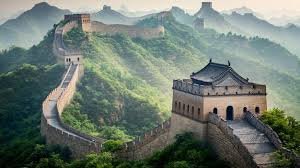The Great Wall of China stands as one of the most iconic landmarks in the world, stretching across thousands of miles and symbolizing centuries of history, engineering brilliance, and cultural significance. Recognized as one of the New Seven Wonders of the World, this architectural marvel continues to attract millions of tourists every year. In this article, we will explore the history, construction, significance, and interesting facts about the Great Wall of China.
History of the Great Wall of China
The origins of the Great Wall date back to the 7th century BC when individual states in China built walls for protection. However, it was during the reign of Emperor Qin Shi Huang (221-206 BC) of the Qin Dynasty that these walls were connected, forming the first unified defense system against invasions from northern tribes.
Later, during the Ming Dynasty (1368-1644), the wall was extensively renovated and expanded to its current form. The Ming rulers focused on strengthening the structure using bricks, stones, and wood, adding watchtowers, fortresses, and sophisticated signaling systems to enhance security.
Architectural Brilliance and Construction
The Great Wall spans approximately 13,171 miles (21,196 kilometers), stretching across mountains, deserts, and plateaus. Its construction utilized a variety of materials, including:
Rammed earth (in the early phases)
Wood and reeds (in some sections)
Bricks and stones (mostly during the Ming Dynasty)
The wall’s height varies, averaging 20-26 feet (6-8 meters), while its width ranges from 13-16 feet (4-5 meters). This massive structure includes watchtowers, barracks, signal beacons, and fortifications, showcasing a brilliant military defense strategy.
Purpose and Strategic Importance
The primary purpose of the Great Wall was to protect China from invasions, particularly from the Mongols and other northern nomadic tribes. It also served as:
A means of communication using smoke signals, flags, and beacon fires.
A trade route checkpoint, helping regulate goods and taxation along the Silk Road.
A symbol of imperial power and unity in Chinese history.
Tourism and Popular Sections
Today, the Great Wall of China is one of the most visited landmarks in the world, drawing millions of tourists annually. Some of the most famous sections include:
Badaling – The most visited and well-preserved section, located near Beijing.
Mutianyu – A scenic and less crowded section with breathtaking views.
Jiankou – Known for its steep and wild terrain, ideal for adventure seekers.
Simatai – Famous for its original features and stunning night views.
Jinshanling – A favorite spot for photographers due to its picturesque setting.
Interesting Facts About the Great Wall
Contrary to popular belief, the Great Wall is not visible from the moon with the naked eye.
It took over 2,000 years to complete different phases of the wall.
Over 1 million workers contributed to its construction, many of whom lost their lives, earning it the name “the longest cemetery in the world.”
Some sections of the wall are in serious disrepair due to erosion, vandalism, and natural disasters.
In 1987, the UNESCO World Heritage Site designation was granted to the Great Wall, solidifying its cultural importance.
Challenges in Preservation
Despite being one of the most treasured historical sites, the Great Wall faces several threats:
Erosion and weathering due to natural elements.
Human destruction, including theft of bricks for construction in nearby villages.
Tourism impact, leading to wear and tear in some sections.
Government efforts to restore and preserve the wall are ongoing, but more initiatives are needed.
Conclusion
The Great Wall of China is more than just an architectural wonder; it is a symbol of resilience, history, and cultural pride. Its grandeur and historical significance continue to inspire millions worldwide. Whether you’re a history enthusiast, an adventurer, or simply a traveler seeking breathtaking views, visiting the Great Wall should be on your bucket list!
With its rich history, remarkable construction, and global recognition, the Great Wall remains a testament to human ingenuity and the enduring spirit of China. As we work towards preserving this magnificent site, it will continue to stand tall as one of the greatest wonders of the world.


